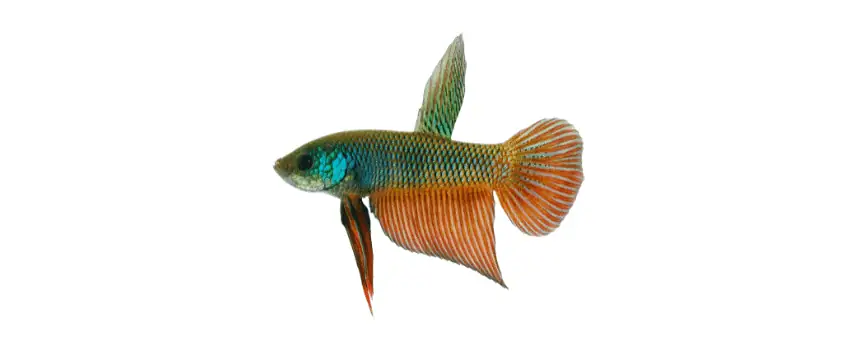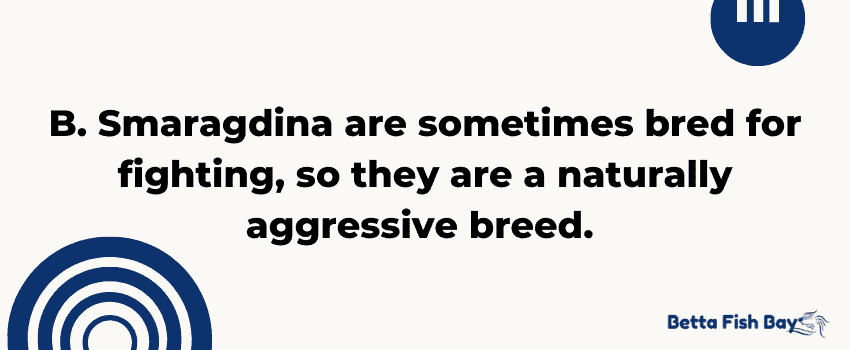Betta smaragdina is a gorgeous species of fish and a popular option among fish keepers.
Its name derives from the Latin word smaragdinus, which means “emerald-colored.” This is where it gets its other name, Emerald Betta.
The smaragdina species is native to Eastern Thailand and parts of Malaysia. These bettas occur in marshes, ditches, and other shallow bodies of water.
While this species is wild, it has been bred in Thailand for aggression.
If you want to keep this variation of the standard betta, you’ll need to know everything about it. But this is exactly why we wrote this article!
Table of Contents
Appearance

Betta fish exhibit sexual dimorphism. This means male and female bettas have differences in appearance.
Male Betta smaragdinas have bodies reddish-brown in color. They boast lovely blue or green iridescent scales, which are striking to look at.
Their bodies also feature a faded stripe pattern. Their fins are blue and red in color.
Female Betta smaragdinas have brown bodies and tend to feature muted colors.
Additionally, their fins and beards are less prominent than the males’.
Unique Differences
Betta smaragdina in the wild may have poor genetics due to hybridization.
In recent years, fish keepers have released domestic bettas to mate with wild ones. This has resulted in genetic issues shortening the offspring’s life expectancy.
Betta fish with genetic conditions are usually more prone to diseases and infections. It’s critical to take extra measures to keep water within optimal parameters.
Generally, you won’t have to worry about your Betta smaragdina having genetic conditions. The issue affects wild-born smaragdinas bred from a wild betta and a domestic betta.
Another unique feature of Betta smaragdina is their slightly upturned jaw. This is also due to the breeding between domestic and wild species.
Lifespan
The Betta smaragdina lifespan is from three to five years in captivity.
The best way to extend your bettas’ lives is to give them the proper care and environment.
Here are a few tips for increasing your bettas’ lifespan:
- Keep tank water within optimal parameters
- Feed your bettas a varied diet high in protein
- Ensure the tank setup mimics their natural environment
- Watch their behavior for signs of illness, stress, or aggression
Average Size
Betta smaragdina can grow to be from 2-2.5″ inches long.
Male bettas tend to grow larger than females, sometimes exceeding 2.5″ inches.
Betta Smaragdina Care
Since Betta smaragdinas are tropical fish, they need specific living conditions to thrive.
Here are some useful tips on tank size and setup, water parameters, diet, diseases, and more.
Tank Size
The smallest tank size for a single Betta smaragdina is five gallons. But expert aquarists suggest ten gallons is the ideal size for this species.
If you plan to house a sorority or community tank, the aquarium will need to be at least 30 gallons. Betta smaragdina are territorial, and they need plenty of space.
Here’s a link to our review of a good 6-gallon betta tank.
Water Parameters
Betta smaragdinas need specific water parameters to thrive:
Ideal Water Parameters for a Betta Fish Tank Include the following:
- Temperature: 78-80° degrees Fahrenheit (25.5-27° C)
- pH: 6.5-7.5
- Ammonia and Nitrite: 0 ppm
- Nitrate: < 40 ppm
- gH: 3-4 dGH (50-66.7 ppm)
- kH: 3-5 dKH (53.6-89.4 ppm)
- Minimum Tank Size: 5 Gallons
Since Betta smaragdinas are prone to diseases, ensure you keep their tank clean:
- Perform frequent water changes
- Treat the water with conditioner
- Remove uneaten food from the tank
Also, consider installing a low-flow tank filter and buying a water test kit.
These will help keep the water clean and ensure you always know the water conditions.
A weekly water change is critical in keeping these levels stable too.
Read more about how often to change betta water and the right way to go about it in our article here.
What To Put In Their Tank
Your bettas will thrive when you model their aquarium after their natural environment.
Betta smaragdinas enjoy environments with lots of plants.
They especially prefer floating plants, such as Salvinia or Riccia spp.
Another great addition to the B. Smaragdina tank is driftwood. This both provides an excellent hiding place and adds essential tannins to the water.
Finally, your B. smaragdina will enjoy having a leaf litter substrate. This will mimic its natural environment in Southeast Asia’s plant-filled, brackish water.
Possible Diseases

B. smaragdina bred from a domestic betta and wild betta are especially prone to health issues.
There are several diseases your bettas may experience:
- Dropsy
- Ich
- Swim bladder issues
- Popeye
- Fin and tail rot
They are also prone to becoming infected with parasites, such as the following:
- Gill flukes
- Anchor worms
- Betta fish lice
To help prevent diseases and infections, keep the tank water within optimal parameters.
Perform water changes, treat the water, and watch your bettas for signs of illness.
If you suspect your betta is sick, have it examined by a certified vet.
They will give a proper diagnosis and suggest the best course of treatment.
Remember, a stable environment and constant vigilance are key to keeping your fish alive for a long time.
Food & Diet
B. smaragdina are carnivorous fish. In their wild habitat, they like to eat snails and bloodworms.
We recommend feeding your bettas a varied diet to keep them healthy.
Betta fish have specific nutritional needs. Eating many different foods helps them meet these needs. It’s especially crucial to focus on incorporating protein and fiber into their diet.
There are several types of betta food products available on the market today:
- Live foods
- Frozen foods
- Freeze-dried foods
- Pellets
- Flakes
Live and frozen foods tend to provide the most nutritional value. They also provide bettas with a feeding experience reflective of their natural instincts.
Freeze-dried foods are more convenient and affordable than live/frozen foods. They still provide decent nutrition, making them an attractive option for fish keepers.
Pellets and flakes are betta food products containing a range of essential nutrients. Most bettas prefer pellets over flakes, and pellets are also easier to clean up.
For more information on diet, check out our popular post on how often to feed your betta and what it needs for a healthy life.
Behavior & Temperament

B. smaragdina is a particularly aggressive betta species.
Here are some tips to help you avoid aggression issues with your bettas:
- Do not house male bettas together. Male bettas are more aggressive than females. Because of their territorial nature, they will fight and kill each other if housed in the same tank.
- Avoid overcrowding in tanks. B. smaragdinas need a lot of space to roam, especially if they’re living with other fish. Overcrowding stresses out your bettas, making them more aggressive towards each other.
- Include plenty of hiding places. Since betta fish are territorial and aggressive by nature, they need space and places to hide. Consider adding driftwood and decorations to the tank for extra privacy.
- Watch your bettas’ behavior. Check your bettas’ behavior to see if there are any signs of aggression or bullying. Symptoms may include flashing, flaring, hiding, or staying near the top of the tank.
If your bettas are aggressive towards each other, you may need to house them in separate tanks.
Tank Mates
B. smaragdina is a rather aggressive fish, so it can only live with certain tank mates.
Some of the best tank mates for this fish species include the following:
- Tetra
- Corydora
- Shrimp
- Snails
If you house your bettas with smaller creatures like shrimp or snails, they may turn them into a snack.
In general, you don’t want to give this betta a tank mate who is smaller than them. Even a matching-size fish may not do.
Remember, in Thailand, this fish species is bred for fighting.
It’s aggressive. Giving it a larger friend will help prevent the chances of your betta picking fights.
Another important note: Do not house male Betta smaragdinas together.
They will be aggressive towards each other and engage in fights. Sometimes, this will result in one or more of your bettas dying.
It’s usually okay to house females together in a sorority or community tank. But if you notice issues with aggression, you may need to give each betta its own tank.
Breeding
B. smaragdina, like Betta splendens, are bubble nesters. This means the male betta builds a bubble nest to impress the female and keep the fertilized eggs safe.
When breeding this betta species, ensure the breeding tank is at least 10 or 15 gallons. If the tank is too small, the breeding pair may become aggressive and anxious.
Keep the betta pair in the same tank, separated by a clear barrier. Let them get used to each other for up to two weeks, and watch them for signs they’re ready to mate.
Signs include the male building a bubble nest and the female’s appearance changing.
Once this happens, remove the barrier.
The bettas will engage in their mating dance. This consists of the bettas twisting around each other. During the dance, the female releases eggs and the male releases sperm over them.
The male places the fertilized eggs in the bubble nest. They will hatch in two to three days, during which time the male guards and protects them.
The little bettas, called fry, will hatch in two or three days. The male no longer cares for the free-swimming fry, and he leaves them to grow on their own.
After getting the little fish, you’ll need to know how to care for them.
Check out more on this in our guide to betta fry care.
Price
On average, buying a B. smaragdina will set you back $35–$55.
They may be pricier than this if, for example, the fish has more vivid coloring or a prominent pattern.
Rarity
B. smaragdina is a pretty rare betta species.
If you want to buy this species of betta, opt for local breeders. This comes with several benefits:
- It allows you to examine fish quality yourself.
- It gives you a chance to form relationships with fellow betta keepers.
- It ensures the betta doesn’t perish in transfer (a common issue).
Commonly Asked Questions about Betta Smaragdina

Betta smaragdina is a gorgeous aquarium fish and a favorite among betta enthusiasts. Here are answers to some of the most common questions about this unique betta species.
Are Betta Smaragdina Peaceful?
Betta smaragdina is not considered a peaceful betta species. This species of bettas is bred for fighting and aggression. As such, they are territorial and aggressive towards males of the same species.
It’s critical not to house male Betta smaragdina together. Each male betta needs its own tank, separate from other bettas. If you want your betta to have tank mates, ensure the ones you choose are optimal for this species.
Can Betta smaragdina live together?
For the most part, B. smaragdina should live by itself. This betta species is especially aggressive and territorial, making them prone to fighting.
Avoid housing two male betta fish together, as they will fight and attempt to kill each other.
It’s usually okay to house a few female bettas together in a sorority. But B. smaragdinas are more aggressive than females of other species. This means the arrangement sometimes doesn’t work out.
Your best option might be to house a single male with some compatible non-betta tank mates.
What is the difference between Betta mahachai and Betta smaragdina?
Betta smaragdina and Betta mahachaiensis are two similar-looking species. But there are some key differences in appearance to keep in mind.
Betta smaragdina
Betta smaragdinas feature reddish-orange ventrals. Their anal fins tend to have orange or blue accents with white tips.
Additionally, they have snake-like scales on their faces.
Betta mahachaiensis
Betta mahachaiensis, on the other hand, has black ventrals with blue or green accents. Their anal fins are usually a bluish-green color.
Unlike smaragdinas, this species features plated scales on their faces.


